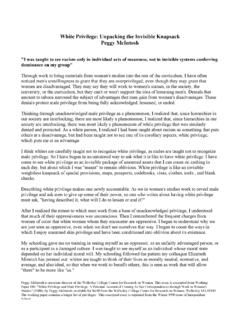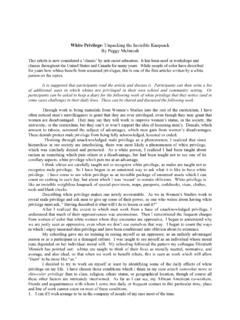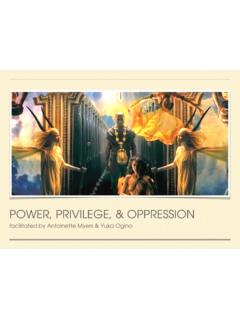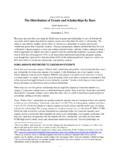Transcription of Privilege Walk VERSION A - What's Race
1 Privilege walk VERSION A This exercise was adapted from Peggy McIntosh s article white Privilege : Unpacking the Invisible Knapsack by Dave Stark, the co-facilitator featured in the documentary What s Race Got to Do with It? (available on DVD from ). For more information on the film and other engagement activities, visit In this variation on the traditional Privilege walk , participants come together after each statement rather than move farther and farther apart. This VERSION emphasizes the many ways we can be divided as well as areas of commonality. Instructions: 1. Have participants form a single line and hold hands. Ask everyone to listen carefully and maintain silence throughout the exercise.
2 2. Tell participants that you are going to read off a series of statements. After each statement, you ll form two groups. 3. Tell participants that if the statement is true for them, they should release their hands, step forward, then turn around and face the other group. If the statement is not true for them, participants should remain where they are. (People usually get the hang of this after a few tries, so it s a good idea to start with easier statements first.) 4. After each statement, allow participants a few minutes to note who is standing where, then ask everyone to return to their original positions and hold hands again. Then read off the next statement.
3 5. After you ve read and processed all the statements, have everyone form a circle for discussion. Statements: It was assumed from a young age that you would go to college. You are not followed when you enter a store. Your parents do not have a foreign accent. You grew up in a house owned by your parents. No one in your immediate family has ever been addicted to drugs or alcohol. You have never gone homeless or hungry for a day or more out of necessity. You went on regular family vacations and had a maid or a gardener. You don t have to cope with frequent catcalls because of your gender. You can legally marry anyone you might fall in love with.
4 You will graduate from one of the world s elite universities. Follow-up questions for discussion: How did this exercise make you feel? Which statements stood out for you the most? What have you learned from this experience? What can you do with this information in the future? Other statements to include or think about during discussion: Your parents and grandparents were able to purchase or rent housing in any neighborhood they could afford. 2006 California Newsreel. - 1 - You can take a job with an employer who believes in affirmative action without having co-workers suspect that you got it because of your race.
5 You can look in mainstream media and see wide, fair representation of people who look like you. You grew up in a safe neighborhood with good schools. You can go shopping most of the time, pretty well assured that you will not be followed or harassed. If your car breaks down on a deserted stretch of road, you can trust that the law enforcement officer who shows up will be helpful. You don't have to worry about helping your parents out when they retire. You never think twice about calling the police when trouble occurs. Schools in your community teach about your race and heritage and present it in positive ways. You can be pretty sure that if you go into a business and ask to speak to the "person in charge" that you will be facing a person of your race.
6 2006 California Newsreel. - 2.









